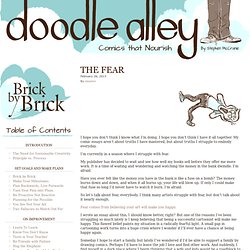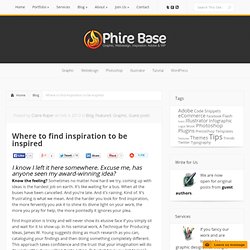

THE FEAR. I hope you don’t think I know what I’m doing.

I hope you don’t think I have it all together. My comic essays aren’t about truths I have mastered, but about truths I struggle to embody everyday. I’m currently in a season where I struggle with fear. My publisher has decided to wait and see how well my books sell before they offer me more work. It is a time of waiting and wondering and watching the money in the bank dwindle.
Have you ever felt like the money you have in the bank is like a fuse on a bomb? So let’s talk about fear, everybody. Fear comes from believing your art will make you happy. I wrote an essay about this, I should know better, right? Steal Like an Artist: 10 Things Nobody Told You About Being Creative (9780761169253): Austin Kleon. Where to find inspiration to be inspired. I know I left it here somewhere.

Excuse me, has anyone seen my award-winning idea? Know the feeling? Sometimes no matter how hard we try, coming up with ideas is the hardest job on earth. It’s like waiting for a bus. When all the buses have been cancelled. Find Inspiration is tricky and will never show its elusive face if you simply sit and wait for it to show up. Be inspired... Source: link In bed You’ll like this one. Source: link Online The brilliant TED Talks videos cover a huge range of discussion topics fronted by credible and fascinating speakers. Source: link In nature Get out of the office and go somewhere.
Source: link In play To be creative you need to be feeling playful. Source: link In a bar Now we’re not suggesting you go out and get blind drunk. Source: link On a train People are brilliant. Source: link On paper Grab a pen and notebook and start to write. Your Art is Not Your Identity by ~StephenMcCranie on deviantART. Productivity Articles at Stepcase Lifehack. Twenty Rules of Thumb for Creativity. Twenty Rules of Thumb for Creativity 1.

The best way to get great ideas is to get lots of ideas and throw the bad ones away. 2. Create ideas that are fifteen minutes ahead of their time...not light-years ahead. The Science of Studying. Tackle Any Issue With a List of 100. The List of 100 is a powerful technique you can use to generate ideas, clarify your thoughts, uncover hidden problems or get solutions to any specific questions you’re interested in.

The technique is very simple in principle: state your issue or question in the top of a blank sheet of paper and come up with a list of one hundred answers or solutions about it. “100 Ways to Generate Income”, “100 Ways to be More Creative” or “100 Ways to Improve my Relationships” are some examples. “One hundred entries? Isn’t that way too many?” Bear with me: it’s exactly this exaggeration that makes the technique powerful. When starting your list you may believe that there’s no way to get it done.
Unlike the related Idea Quota tool — whose primary goal is to acquire the habit of coming up with ideas — the goal of a List of 100 is to take your mind by surprise. Ground Rules There are only two simple principles to keep in mind when making Lists of 100: How to Ace Your Finals Without Studying & Scott H Young. I’ve never been that keen on studying before an exam.

I rarely study for more than a half hour, even for big final exams worth more than half my grade. When I do study, I usually just skim over the material and do a few practice questions. For some of my math classes I have yet to do a single practice question for homework. Most people study by cramming in as much information before walking into the test room, whereas I consider studying to be no more than a light stretch before running. Despite what some might point out as horrible studying habits, I’ve done very well for myself in school.
It’s very easy to look at my successes and apparent lack of effort and quickly deem that it is an innate gift, impossible to replicate. Webs and Boxes The system I use for learning I’m going to call holistic learning. People who learn through compartments, try to organize their mind like a filing cabinet. Holistic learning takes an opposite approach. Very few people are purely compartmental learners.